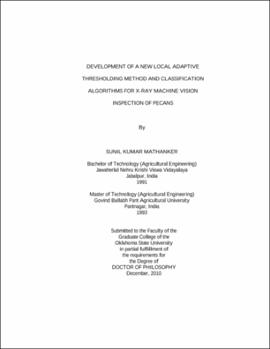| dc.contributor.advisor | Weckler, Paul R. | |
| dc.contributor.author | Mathanker, Sunil Kumar | |
| dc.date.accessioned | 2013-11-26T07:43:15Z | |
| dc.date.available | 2013-11-26T07:43:15Z | |
| dc.date.issued | 2010-12 | |
| dc.identifier.uri | https://hdl.handle.net/11244/6418 | |
| dc.description.abstract | Scope and Method of Study: | |
| dc.description.abstract | This study evaluated selected local adaptive thresholding methods for pecan defect segmentation and proposed a new method: Reverse Water Flow. Good pecan nuts and fabricated defective pecan nuts were used for comparison, in addition to images from published research articles. For detailed comparison, defective and good pecans, 100 each, were collect from a mechanical sorter operating at Pecan Research Farm, Oklahoma State University. To improve classification accuracy and reduce the decision time AdaBoost and support vector machine classifiers were applied and compared with Bayesian classifier. The data set was randomly divided into training and validation sets and 300 such runs were made. | |
| dc.description.abstract | Findings and Conclusions: | |
| dc.description.abstract | A new local adaptive thresholding method with a new hypothesis: reversing the water flow and a simpler thresholding criterion is proposed. The new hypothesis, reversing the simulated water flow, reduced the computational time by 40-60% as compared to the existing fastest Oh method. The proposed method could segment both larger and smaller (presence of insect exit paths) defects. The proposed method worked well for other unimodal images taken from published research studies and it should be extendable to other food and agricultural images characterized by unimodal histogram and poor contrast. | |
| dc.description.abstract | The proposed method and Twice Otsu method worked best for the collected pecan samples. For the proposed method, the radial support vector machine reduced error rates by 2.83% and classification time by 62.33% compared to Bayesian classifier. The Real AdaBoost algorithm reduced error rate by 4.96% and classification time by 97.73%. The linear support vector machine classification accuracy was 92.68% with Twice Otsu segmentation method. The Real AdaBoost classification accuracy was 92.28% with the reverse water flow segmentation method. Further evaluation with features representing smaller defects (insect exit holes) should improve the classifier performance with the reverse water flow segmentation method. | |
| dc.format | application/pdf | |
| dc.language | en_US | |
| dc.rights | Copyright is held by the author who has granted the Oklahoma State University Library the non-exclusive right to share this material in its institutional repository. Contact Digital Library Services at lib-dls@okstate.edu or 405-744-9161 for the permission policy on the use, reproduction or distribution of this material. | |
| dc.title | Development of a new local adaptive thresholding method and classification algorithms for x-ray machine vision inspection of pecans | |
| dc.contributor.committeeMember | Bowser, Timothy J. | |
| dc.contributor.committeeMember | Wang, Ning | |
| dc.contributor.committeeMember | Maness, Niels O. | |
| dc.contributor.committeeMember | Fan, Guoliang | |
| dc.contributor.committeeMember | Stone, Marvin | |
| osu.filename | Mathanker_okstate_0664D_11121.pdf | |
| osu.accesstype | Open Access | |
| dc.type.genre | Dissertation | |
| dc.type.material | Text | |
| dc.subject.keywords | adaboost | |
| dc.subject.keywords | food safety x-ray machine vision inspection | |
| dc.subject.keywords | local adaptive thresholding | |
| dc.subject.keywords | non-destructive testing | |
| dc.subject.keywords | patt | |
| thesis.degree.discipline | Biosystems and Agricultural Engineering | |
| thesis.degree.grantor | Oklahoma State University | |
